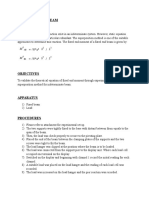Statics Module1
Uploaded by
Glenn Paul TalhaStatics Module1
Uploaded by
Glenn Paul TalhaCOURSE: ES 211 Statics of Rigid Bodies
YEAR/SECTION: 2nd Year BSABE & BSCE
TIME FRAME: 100 Minutes
TARGET NO. OF SESSIONS: Two (2) Sessions
RESOURCES/MATERIALS NEEDED: Pen, Paper, Calculator
MODULE 1: UNIT OF MEASUREMENT CONVERSION
After completing this module,
Students will be able to convert units from customary system to SI system.
INTRODUCTION
Mechanics is a branch of the physical sciences that is concerned with the state of rest or
motion of bodies that are subjected to the action of forces.
Subdivided into three branches:
rigid-body mechanics
deformable-body mechanics
fluid mechanics
Rigid-Body Mechanics is essential for the design and analysis of many types of structural
members, mechanical components, or electrical devices encountered in
engineering.
Divided into two areas: statics and dynamics
Statics deals with the equilibrium of bodies, that is those that are either at rest or move
with constant velocity.
Dynamics is concerned with the accelerated motion of bodies.
Newton’s Three Laws of Motion
1. If a particle is at rest (or moving with constant velocity in a straight line), it will
remain at rest (or continue to move with constant velocity in a straight line)
unless acted upon by a force.
2. A particle acted upon by a force will accelerate in the direction of the force. The
magnitude of the acceleration is proportional to the magnitude of the force and
inversely proportional to the mass of the particle.
3. For every action, there is an equal and opposite reaction; that is, the forces of
interaction between two particles are equal in magnitude and oppositely
directed along the same line of action.
UNIVERSITY OF SOUTHERN MINDANAO
College of Engineering and Information Technology
1st Semester SY 2020-2021
UNITS OF MEASUREMENT
SI Units. The International System of units, abbreviated SI after the French “Système
International d’Unités,” is a modern version of the metric system, which has received
worldwide recognition.
The SI system defines length in meters (m), time in seconds (s), and mass in kilograms
(kg). The unit of force, called a newton (N), is derived from F = ma. Thus, 1 newton is
equal to a force required to give 1 kilogram of mass an acceleration of 1 m/s² (N =
kg·m/s²).
From the formula W=mg, (g=9.81 m/s²), a body of mass 1 kg has a weight of 9.81 N.
U.S. Customary. In the U.S. Customary system of units (FPS) length is measured in feet (ft),
time in seconds (s), and force in pounds (lb).
The unit of mass, called a slug, is derived from F = ma. Hence, 1 slug is equal to the
amount of matter accelerated at 1 ft/s² when acted upon by a force of 1 lb (slug =
lb·s²/ft).
From the formula W=mg, (g=32.2 ft/s²), a body of weighing 32.2 lb has a mass of 1
slug.
Four basic quantities – length, time, mass and force; are not all independent from one
another.
SYSTEM OF UNITS PREFIXES
CONVERSION FACTORS
UNIVERSITY OF SOUTHERN MINDANAO
College of Engineering and Information Technology
1st Semester SY 2020-2021
Rules for Use. Here are a few of the important rules that describe the proper use of the
various SI symbols:
• Quantities defined by several units which are multiples of one another are separated by a
dot to avoid confusion with prefix notation, as indicated by N = kg ·m/s2 = kg·m·s-2.
Also, m·s (meter-second), whereas ms (milli-second).
• The exponential power on a unit having a prefix refers to both the unit and its prefix. For
example, μN2 = (μN) 2 = μN· μN. Likewise, mm2 represents (mm) 2 = mm·mm.
• With the exception of the base unit the kilogram, in general avoid the use of a prefix in the
denominator of composite units. For example, do not write N/mm, but rather kN/m;
also, m/mg should be written as Mm/kg.
• When performing calculations, represent the numbers in terms of their base or derived
units by converting all prefixes to powers of 10. The result should then be expressed
using a single prefix. Also, after the calculation, it is best to keep numerical values
between 0.1 and 1000; otherwise, a suitable prefix should be chosen.
For example, (50 kN) (60 nm) = [50(103) N] [60(10-9) m]
= 3000(10-6) N · m = 3(10-3) N ·m = 3 mN·m
Significant Figures.
The number of significant figures contained in any number determines the accuracy of
the number.
4981 contains four significant figures
Zeros occur at the end of a whole number is significant
For example,
23 400 has five significant figures = 23.400(103) with only three significant figures, it
is written as 23.4(103)
Note: engineering notations of (103), (106), (109)
If zeros occur at the beginning of a number that is less than one, then the
zeros are not significant.
For example, 0.008 21 has three significant figures = 8.21(10–3)
0.000 582 can be expressed as 0.582(10–3) or 582(10–6)
Rounding Off Numbers. Rounding off a number is necessary so that the accuracy of the
result will be the same as that of the problem data.
Number greater than five is rounded up and a number less than five is not rounded up.
Examples of rounding off to three significant figures:
3.5587 is rounded up to 3.56
0.5896 becomes 0.590 and 9.3866 becomes 9.39
1.341 digit (1) is less than 5, then we get 1.34
0.3762 becomes 0.376 and 9.871 becomes 9.87
There is a special case for any number that ends in a 5. As a general rule, if the digit
preceding the 5 is an even number, then this digit is not rounded up. If the digit
preceding the 5 is an odd number, then it is rounded up.
For example, 75.25 rounded off to three significant digits becomes 75.2,
0.1275 becomes 0.128, and 0.2555 becomes 0.256
UNIVERSITY OF SOUTHERN MINDANAO
College of Engineering and Information Technology
1st Semester SY 2020-2021
Examples
1 3
UNIVERSITY OF SOUTHERN MINDANAO
College of Engineering and Information Technology
1st Semester SY 2020-2021
Exercises
1. Represent each of the following as a number between 0.1 and 1000 using an appropriate prefix: (a)
42 523 kN, (b) 628(115) mm, and (c) 0.00723 mg.
2. Evaluate each of the following to three significant figures and express each answer in SI
units using an appropriate prefix: (a) (256 mN)2, (b) (71 317 ms)2, and
(c) [358(106)]1/2 ms.
3. If a man weighs 165 lb on earth, specify (a) his mass in slugs, (b) his mass in kilograms,
and (c) his weight in newtons. If the man is on the moon, where the acceleration due to
gravity is gm = 5.30 ft/s2, determine (d) his weight in pounds, and (e) his mass in
kilograms.
4. The pascal (Pa) is actually a very small unit of pressure. To show this, convert 1 Pa = 1
N/m2 to lb/ft2. Atmosphere pressure at sea level is 14.7 lb/in2. How many pascals is this?
5. A concrete column has a diameter of 298 mm and a length of 2.75 m. If the density
(mass/volume) of concrete is 2.45 Mg/m3, determine the weight of the column in pounds.
Reference:
Hibbeler, R. C. (2016). Engineering Mechanics_Statics & Dynamics 14th Ed. United States of America: Pearson
Prepared by: Engr. Bernadeth V. Dapun
ES 211 Instructor
UNIVERSITY OF SOUTHERN MINDANAO
College of Engineering and Information Technology
1st Semester SY 2020-2021
You might also like
- Engineering Mechanics: Statics: General PrinciplesNo ratings yetEngineering Mechanics: Statics: General Principles45 pages
- GEN PHYSICS 1 MODULE (Midterm and Finals)No ratings yetGEN PHYSICS 1 MODULE (Midterm and Finals)49 pages
- General Physics (PHYS101) : Golibjon BerdiyorovNo ratings yetGeneral Physics (PHYS101) : Golibjon Berdiyorov26 pages
- UNSW-skills in Experimentation Workbook1No ratings yetUNSW-skills in Experimentation Workbook159 pages
- Chapter One Physics and Measurements: PSUT-Basic Science DepartmentNo ratings yetChapter One Physics and Measurements: PSUT-Basic Science Department25 pages
- Today's Objectives:: Statics, Units, Calculations & Problem SolvingNo ratings yetToday's Objectives:: Statics, Units, Calculations & Problem Solving22 pages
- Prepared by Engr. Larissa G. Saculles: 08 Jan 2024 - EngrlgsNo ratings yetPrepared by Engr. Larissa G. Saculles: 08 Jan 2024 - Engrlgs13 pages
- Introduction to measurements_250316_172112No ratings yetIntroduction to measurements_250316_17211246 pages
- SLM General Physics 1 - Q1 - Weeks 1 To 4No ratings yetSLM General Physics 1 - Q1 - Weeks 1 To 431 pages
- Physics 1: Mechanics: Engr. Abraham M. Heriales, PH.D100% (2)Physics 1: Mechanics: Engr. Abraham M. Heriales, PH.D22 pages
- Chapter 1-Physical Quantities Units and DimensionsNo ratings yetChapter 1-Physical Quantities Units and Dimensions4 pages
- The SI System of Fundamental and Derived Units 2021 573466No ratings yetThe SI System of Fundamental and Derived Units 2021 5734667 pages
- The Realm of Physics: Sub-Nuclear Particles: 10 M Extent of The Visible Universe: 10 MNo ratings yetThe Realm of Physics: Sub-Nuclear Particles: 10 M Extent of The Visible Universe: 10 M18 pages
- Chapter Objectives: Idealizations of MechanicsNo ratings yetChapter Objectives: Idealizations of Mechanics27 pages
- General Physics 1 ADM Module 1 4 FINAL 2No ratings yetGeneral Physics 1 ADM Module 1 4 FINAL 233 pages
- Units, Physical Quantities, Measurement, Errors and Uncertainties, Graphical Presentation, and Linear Fitting of DataNo ratings yetUnits, Physical Quantities, Measurement, Errors and Uncertainties, Graphical Presentation, and Linear Fitting of Data87 pages
- Chapter One: Introduction To Physics, Units and MeasurementsNo ratings yetChapter One: Introduction To Physics, Units and Measurements28 pages
- Barron's Physics Practice Plus: 400+ Online Questions and Quick Study ReviewFrom EverandBarron's Physics Practice Plus: 400+ Online Questions and Quick Study ReviewNo ratings yet
- Ce6306 Strength of Materials Lecture NotesNo ratings yetCe6306 Strength of Materials Lecture Notes34 pages
- Vibration Damping Techniques in Wind Turbine BladesNo ratings yetVibration Damping Techniques in Wind Turbine Blades16 pages
- Quadcopter Simulation: Jose Carlos LopezNo ratings yetQuadcopter Simulation: Jose Carlos Lopez4 pages
- Buy Ebook Fundamentals of Nonlinear Optics, Second Edition Peter E. Powers Cheap Price100% (6)Buy Ebook Fundamentals of Nonlinear Optics, Second Edition Peter E. Powers Cheap Price62 pages
- Cs 414 Indian Institute of Technology, BombayNo ratings yetCs 414 Indian Institute of Technology, Bombay17 pages
- PEP 2021 Phase 1 Selection Test 1 - SolutionNo ratings yetPEP 2021 Phase 1 Selection Test 1 - Solution7 pages
- Shannon Entropy Based On The S-Transform Spectrogram Applied On The Classification of Heart SoundsNo ratings yetShannon Entropy Based On The S-Transform Spectrogram Applied On The Classification of Heart Sounds6 pages
- (Ii) Eequatorial : (Ii) E¡xial and For Short Dipole, E¡xial and For Short Dipole EequatorialNo ratings yet(Ii) Eequatorial : (Ii) E¡xial and For Short Dipole, E¡xial and For Short Dipole Eequatorial4 pages
- Newton's Laws of Motion - Wikipedia, The Free EncyclopediaNo ratings yetNewton's Laws of Motion - Wikipedia, The Free Encyclopedia13 pages
- A Study of The Seismic Response of Reinforced Soil Retaining Walls To Rocking Ground ExcitationNo ratings yetA Study of The Seismic Response of Reinforced Soil Retaining Walls To Rocking Ground Excitation11 pages
- Engineering Mechanics: Statics: General PrinciplesEngineering Mechanics: Statics: General Principles
- Chapter One Physics and Measurements: PSUT-Basic Science DepartmentChapter One Physics and Measurements: PSUT-Basic Science Department
- Today's Objectives:: Statics, Units, Calculations & Problem SolvingToday's Objectives:: Statics, Units, Calculations & Problem Solving
- Prepared by Engr. Larissa G. Saculles: 08 Jan 2024 - EngrlgsPrepared by Engr. Larissa G. Saculles: 08 Jan 2024 - Engrlgs
- Physics 1: Mechanics: Engr. Abraham M. Heriales, PH.DPhysics 1: Mechanics: Engr. Abraham M. Heriales, PH.D
- Chapter 1-Physical Quantities Units and DimensionsChapter 1-Physical Quantities Units and Dimensions
- The SI System of Fundamental and Derived Units 2021 573466The SI System of Fundamental and Derived Units 2021 573466
- The Realm of Physics: Sub-Nuclear Particles: 10 M Extent of The Visible Universe: 10 MThe Realm of Physics: Sub-Nuclear Particles: 10 M Extent of The Visible Universe: 10 M
- Units, Physical Quantities, Measurement, Errors and Uncertainties, Graphical Presentation, and Linear Fitting of DataUnits, Physical Quantities, Measurement, Errors and Uncertainties, Graphical Presentation, and Linear Fitting of Data
- Chapter One: Introduction To Physics, Units and MeasurementsChapter One: Introduction To Physics, Units and Measurements
- Barron's Physics Practice Plus: 400+ Online Questions and Quick Study ReviewFrom EverandBarron's Physics Practice Plus: 400+ Online Questions and Quick Study Review
- Vibration Damping Techniques in Wind Turbine BladesVibration Damping Techniques in Wind Turbine Blades
- Buy Ebook Fundamentals of Nonlinear Optics, Second Edition Peter E. Powers Cheap PriceBuy Ebook Fundamentals of Nonlinear Optics, Second Edition Peter E. Powers Cheap Price
- Shannon Entropy Based On The S-Transform Spectrogram Applied On The Classification of Heart SoundsShannon Entropy Based On The S-Transform Spectrogram Applied On The Classification of Heart Sounds
- (Ii) Eequatorial : (Ii) E¡xial and For Short Dipole, E¡xial and For Short Dipole Eequatorial(Ii) Eequatorial : (Ii) E¡xial and For Short Dipole, E¡xial and For Short Dipole Eequatorial
- Newton's Laws of Motion - Wikipedia, The Free EncyclopediaNewton's Laws of Motion - Wikipedia, The Free Encyclopedia
- A Study of The Seismic Response of Reinforced Soil Retaining Walls To Rocking Ground ExcitationA Study of The Seismic Response of Reinforced Soil Retaining Walls To Rocking Ground Excitation

























































































